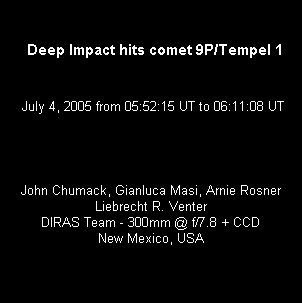Comet 9P/Tempel and Deep Impact: fond memories waiting for DART crashing on Didymos/Dimorphos
On 4 July 2005, the Nasa’s Deep Impact spacecraft impacted on comet 9P/Tempel to investigate the interior of that icy world, pioneering the idea to deliberately hit another astronomical body. While we wait for DART to hit the binary asteroid Didymos – Dimorphos, here it is a precious document from that historic event.

Comet 9P/Tempel increases in brightness, after the collision by the Deep Impact probe, on 4 July 2005.
I clearly remember the excitement in the astronomical community at the beginning of the summer of 2005, when the Nasa’s Deep Impact mission was going to hit comet 9P/Tempel. It was something absolutely new and, as typical in those cases, nobody could say for sure what we could expect to see.
I was one of those eagerly waiting for the collision to happen, for a very precise reason. In my mind, that impact could produce a reasonable increase in brightness of the comet, hopefully within the imaging capabilities of a properly equipped telescope. At that time, I already had a nice set of telescopes at my observatory so I was particularly disappointed to discover I could not monitor the event with my own setup, as it was happening in broad daylight for Italy.
In 2005 remotely controlled telescopes were very rare and I was lucky enough to have access to an awesome system in Las Campanas, Chile, but at the impact time the comet would have just set. But I did not surrender.
I got in touch with a few American observers, having a very nice telescope in New Mexico, from where the comet was still visible above the western horizon (below 20 deg.) at the nominal time of the impact. We managed to schedule a series of images taken around that critical moment, hoping the lowering altitude above the horizon of the target was not a issue. The sky was with us and one of the team (J. Chumak) took care to take the image sequence.
Once the images were made available, I managed to carefully process them. I decided to take three images from the bulk, able to bring the essence of the event. The first image was taken at the impact time, the second one just before the light from the impact reached the Earth (comet 9P was at about 134.5 millions of km from the telescope: it takes about 7.5 minutes to the light to cover that distance) and the last, third image about 11 minutes after the impact. Images were properly normalized, to make possible a real comparison among them.
With those three images, I made the animation visible at the beginning of this post. As we can see, the third frame is showing a comet definitely brighter, while all the other sources (background stars) are the same. The last frame uses pseudo-colors and it shows very clearly the brightness increase.
To my knowledge, the other only available observations done during the impact were performed by the ESA’s Rosetta space mission and Hubble Space Telescope.
Now, I cannot wait for the DART impact on Didymos/Dimorphos – which is something very different from comet 9P and Deep Impact – and hopefully we will see something there, too!
Support The Virtual Telescope Project!
Support us! Please, donate and receive an EXCLUSIVE image of the stunning COMET C/2023 A3 Tsuchinshan-ATLAS and much more, specifically made for supporters like you!
![]()










